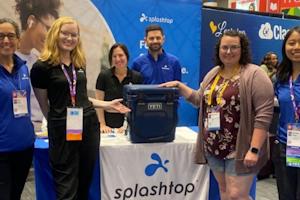Education is undeniably in the middle of transformative shifts, with pandemic-era challenges catapulting progress and digital transformation bringing more opportunities.
In higher education, a hybrid approach to teaching and learning has become a non-negotiable asset for students, faculty, and staff. Today, more than ever, educational institutions are called to focus on students' all-around development, adopting more flexible learning models that enhance their performance, and implementing technological solutions that meet them where they are.
Research conducted by Splashtop at the beginning of this academic year showed that more than 80% of higher-ed students believe their performance would significantly improve with a remote option available for all classes. Furthermore, nearly 40% of respondents stated they would consider switching to a different institution if their current one could not provide flexible learning options.
As students, teachers, and administrators pursue a more efficient life-work-school balance, a growing number of institutions are ready to continue offering blended learning experiences. Despite posing new challenges for IT, this required acceleration in digital transformation can help institutions effectively address issues that have been at the center of the debate for years.
If it’s undeniable that education can no longer have a one-size-fits-all approach, it is also true that the technology used to cater to students must fit all. Remote access tools can democratize education in ways that students have not experienced before, ensuring the same level of accessibility and performance to everyone, anywhere, on any device.
Remote access technology can help higher education institutions remove digital and physical barriers, enhance students’ experience, and provide equitable access to how education is delivered.
Addressing the digital divide for more equitable access to resources
Disparities between students’ backgrounds and economic status exist, and their effects on performance are even more tangible in higher education. Not all students can access a personal device, reliable internet connections, or high-end workstations with resource-intensive software to complete projects.
Both the Splashtop survey and the latest EDUCAUSE QuickPoll revealed that most students use a laptop as their primary device and a smartphone as their secondary device. Financial disparities, combined with requirements to use complex and expensive software for learning purposes, mean that a growing percentage of students struggle to demonstrate the same academic achievements as their more affluent peers. As the EDUCAUSE research recently revealed, these technological barriers have tangible impacts on coursework, which add to the digital divide and amplify student stress.
The impact of these barriers is even more evident in students with disabilities who need reliable access to aiding technology, regardless of the device they are using. Classroom environments can be challenging and stressful for students with learning and physical disabilities. Allowing students to connect to on-campus resources remotely can be an enormous benefit, providing more flexibility to understand materials at their own pace and enhancing their performance.
The shift to remote education also gives administrators more power and flexibility to adapt and tailor course offerings. Remote access technology ensures students can complete lab work and equally access classes, despite any physical or social barriers.
Supporting anyone in the BYOD era
Providing everyone with equitable access to resources, labs and classes is only the first step toward delivering an experience that meets students’ expectations and enhances their performance. As a growing number of students, faculty, and staff use their own devices to access academic resources and services, providing individual support has become just as crucial to enhance the learning experience.
The Splashtop survey found that students use an average of 2 devices, ranging from laptops, smartphones, desktops, tablets, and Chromebooks. Education leaders are called to understand and address the IT and security challenges brought by the digital transformation and use remote support tools and software that can help streamline the troubleshooting process.
Data from EDUCAUSE showed how more than 60% of students experienced at least one tangible impact on their coursework due to technical issues. On the same topic, the Splashtop Student Survey highlighted how nearly 91% of higher-ed students expect to receive on-demand support when experiencing technical issues with learning software and resources.
Remote support technology enables IT teams to provide timely and on-demand assistance to anyone the moment help is needed, regardless of the students’ locations or the devices they are using. High-performing and secure remote support technology allows IT departments to connect to any device from any location, including mobile phones, from a single web console and provide ad-hoc attended and unattended support.
In the last year, centralizing IT management, as well as consolidating and simplifying the toolsets used by educational institutions has become crucial. With decades of disinvestment in IT, the acceleration in digital transformation, and institutions becoming extremely vulnerable to threats, education needs to adopt solutions that streamline IT workflows and support security and compliance requirements. Advanced remote access and support solutions can equalize the way education is delivered and experienced by students and tutors, and to provide IT with advanced security and centralized control.
The onset of new, flexible learning models forever changes the landscape of education. Today, remote access technology revolutionizes how students consume their academic material, bridging the digital divide and empowering institutions, students, and faculty in unprecedented ways. As tech leaders, we must continue to build and improve tools and processes that support educators and IT in delivering secure and equitable blended learning experiences at colleges and universities.
Learn more about Splashtop solutions for education
Splashtop offers remote access solutions for student remote access, faculty remote work, and IT remote support. Check out our Splashtop solutions for education.





